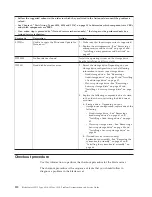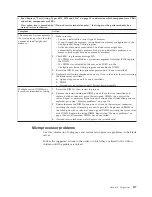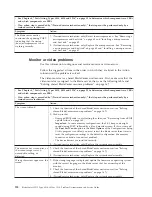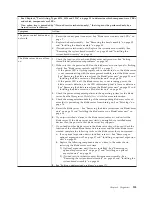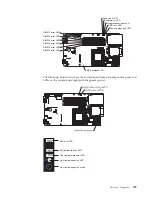
v
See Chapter 4, “Parts listing, Types 8014, 8028 and 1916,” on page 25 to determine which components are CRUs
and which components are FRUs.
v
If an action step is preceded by “(Trained service technician only),” that step must be performed only by a
trained service technician.
Symptom
Action
Not all storage drives are
recognized by the Fixed Disk or
SAS Attached Disk diagnostic
test.
1.
Remove the storage drive that is indicated by the diagnostic tests. See
Chapter 5, “Removing and replacing blade server components,” on page 31.
2.
Run the SAS Fixed Disk or SAS Attached Disk diagnostic test again. See
“Diagnostic tools overview” on page 67.
3.
If the Fixed drive or SAS Attached Disk diagnostic test runs successfully,
replace the storage drive that you removed with a new one. See Chapter 5,
“Removing and replacing blade server components,” on page 31.
The blade server stops
responding during the Fixed
Disk or SAS Attached Disk
diagnostic test.
1.
Remove the storage drive that was being tested when the blade server stopped
responding. See Chapter 5, “Removing and replacing blade server
components,” on page 31.
2.
Run the SAS Fixed Disk or SAS Attached Disk diagnostic test again. See
“Diagnostic tools overview” on page 67.
3.
If the Fixed drive or SAS Attached Disk diagnostic test runs successfully,
replace the storage drive that you removed with a new one. See Chapter 5,
“Removing and replacing blade server components,” on page 31.
A storage drive passes the
Fixed Disk or SAS Attached
Disk diagnostics test, but the
problem remains.
1.
Run the SAS Fixed Disk or SAS Attached Disk diagnostic test again. See
“Diagnostic tools overview” on page 67.
2.
If the Fixed drive or SAS Attached Disk diagnostic test runs successfully but
the storage drive continues to have a problem, replace the drive with a new
one.
Intermittent problems
Use this information to resolve intermittent problems with the blade server.
Follow the suggested actions in the order in which they are listed in the Action
column until the problem is solved.
v
See Chapter 4, “Parts listing, Types 8014, 8028 and 1916,” on page 25 to determine which components are CRUs
and which components are FRUs.
v
If an action step is preceded by “(Trained service technician only),” that step must be performed only by a
trained service technician.
Symptom
Action
A problem occurs only
occasionally and is difficult to
diagnose.
1.
Make sure that:
v
When the blade server is turned on, air is flowing from the rear of the
BladeCenter unit at the blower grille. If there is no airflow, the blower is not
working. This causes the blade server to overheat and shut down.
v
The SAS storage drives are configured correctly.
2.
Check the BMC log (see “Error logs” on page 76).
3.
See “Solving undetermined problems” on page 171.
Keyboard or mouse problems
Use this information to lookup and resolve keyboard or mouse problems.
Follow the suggested actions in the order in which they are listed in the Action
column until the problem is solved. The keyboard and mouse are shared
Chapter 6. Diagnostics
115
Summary of Contents for BladeCenter HS12 Type 1916
Page 1: ...BladeCenter HS12 Type 8014 8028 or 1916 Problem Determination and Service Guide...
Page 2: ......
Page 3: ...BladeCenter HS12 Type 8014 8028 or 1916 Problem Determination and Service Guide...
Page 36: ...24 BladeCenter HS12 Type 8014 8028 or 1916 Problem Determination and Service Guide...
Page 186: ...174 BladeCenter HS12 Type 8014 8028 or 1916 Problem Determination and Service Guide...
Page 190: ...178 BladeCenter HS12 Type 8014 8028 or 1916 Problem Determination and Service Guide...
Page 198: ...186 BladeCenter HS12 Type 8014 8028 or 1916 Problem Determination and Service Guide...
Page 203: ......
Page 204: ...Part Number 60Y1601 Printed in USA 1P P N 60Y1601...












